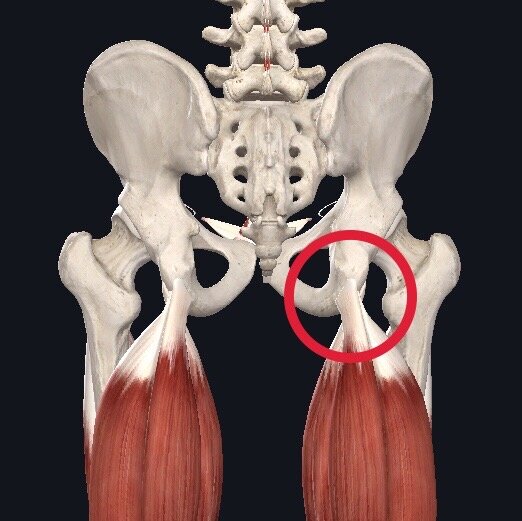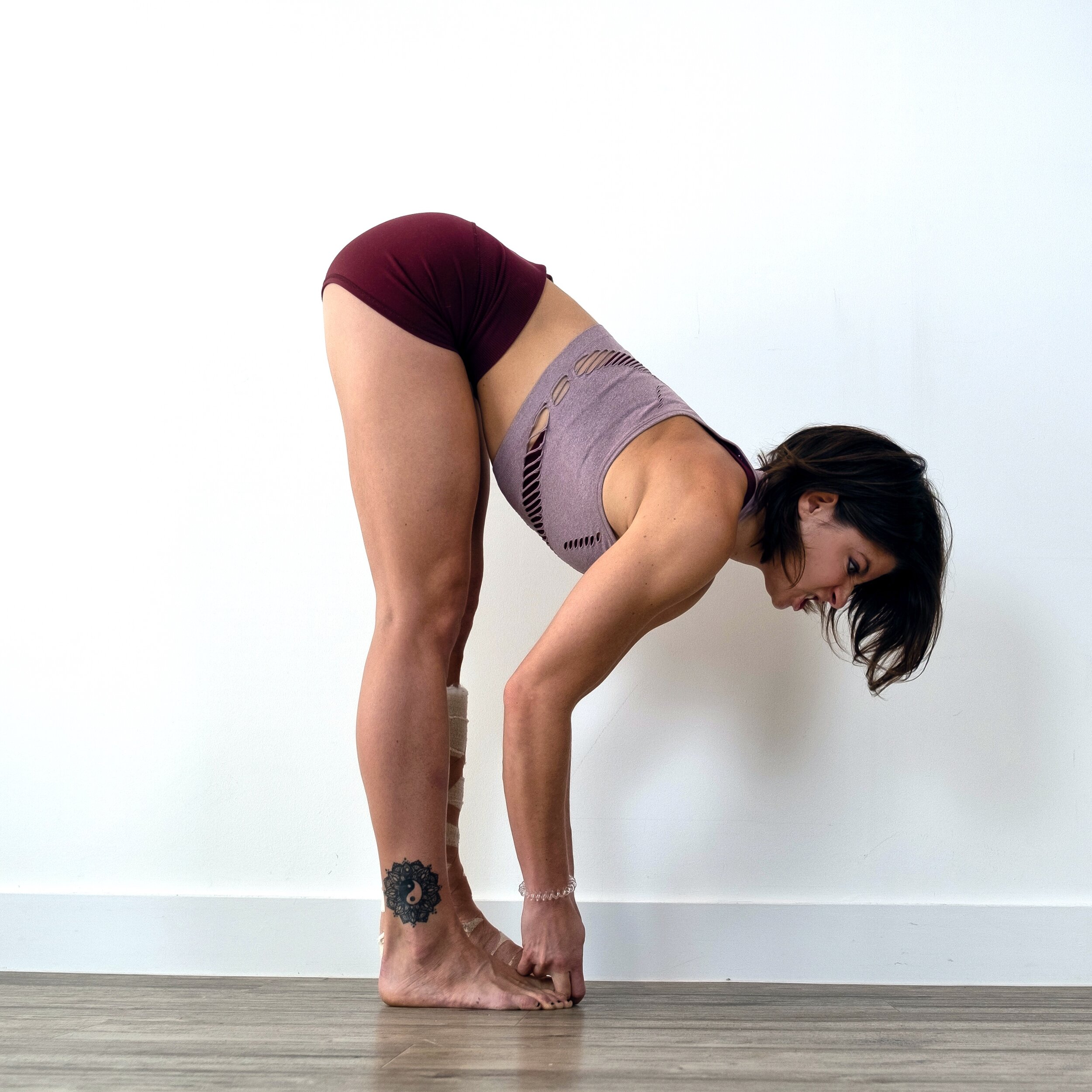Do you have YOGA BUTT? (I hope not...
YOGA BUTT
a.k.a. Proximal hamstring and adductor magnus tendon injury and/or inflammation.
First of all, “yoga butt” it is NOT:
Periformis syndrome
Pain caused by sciatic nerve issues
Inflammation or injury to the labrum
Low back pain
Reference to how good your butt looks if you practice yoga
What it IS:
It is pain at the sit bone (ischael tuberosity) caused by inflammation and/or injury to the tendons that attach to the sit bone, which could be one of three hamstring muscles or one of your adductor muscles (adductor magnus).
Basically, it’s when your butt bone hurts in forward folds.
Unfortunately it can take a long time to heal (think in terms of months, my friend). It can be a literal pain in the butt to sit down.
It often occurs suddenly, when you go into a posture that stretches the hamstrings such as a forward fold or splits.
Sadly, many yogis get it because a yoga teacher has pushed them deeper into a forward bending posture.
(Side note: yoga teachers should NEVER push or pull students deeper into posture. Hands-on assists should be to help a student find length and space in a posture.)
And it’s VERY common. Here's an anatomy slide that may help you visualise what's happening beneath the surface:
Are you a member of Move With Adell yet?
Join my method for staying on track with feeling good, in your body and your mind.
Get unlimited access to a growing library of classes, workshops, workouts, tutorials, and a supportive community.
Before I go further, I want to tell you about my friend Tom. Tom is a yoga teacher, personal trainer, and fitness fanatic who works out intelligently, has a vast anatomy knowledge, eats the cleanest ever diet, and basically is just super duper healthy in every way. And HE is dealing with this injury.
So this isn’t something that happens to you because you’re weak, it isn't something that happens to you because you’re not moving intelligently, it's not an injury reserved for people who sit at a desk all day.
It’s just one of those things that we are very vulnerable to getting. (And yeah, I’ve dealt with it too!)
Why? Why is this so common?
Well first of all, it’s common for the same reason other injuries occur frequently: we tend to injure in areas that get a lot of wear and tear due to moving in the same way over and over again.
And in yoga we do a LOT of forward folds, but we also do a lot of sitting in chairs (which is a forward fold) outside of yoga.
And because of our typical day-to-day chair-sitting posture we get (among other things):
Elongated and weakened glutes
Weak hamstrings that are shortened towards the knee, and longer towards the pelvis (at the sit bone)
An imbalance and feeling of tightness
Because these areas feel tight, we think the answer is stretch stretch stretch.It’s not! What we need is strength!
If you think about movement from an evolutionary point of view, i.e. how our ancestors lived before our modern lifestyle of convenience, when we had to go hunt and gather our food and prepare that food, all of which required lots of walking, running, maybe climbing to get the food. Then we had to pommel, knead, and grind our bounties to prepare it. Furthermore we slept on the ground and walked barefoot and sat in a squatted position —so in those days humans didn’t need to “exercise”. Our duties to get our next meal was enough! And do you think our ancestors bent over to pick mushrooms like this:
No!! How silly!!
I’m not saying forward bending with the knees straight is bad or shouldn’t be done. After all, we’re not our ancestors, we do live in a different world these days, therefore our movement and exercise should reflect what WE need to balance our seated-all-day modern bodies.
But what we need is STRENGTH.
Building strength in our glutes and hamstrings is both what to do if you’re already suffering from yoga butt, and what to do if you want to prevent it.
If you keep your muscles active (contracted) as you lengthen them (stretch), then this teaches your brain that the muscles are here for a reason, and the brain says, “Okay cool, this is absolutely fine here” and you will actually gain the neurological feedback a muscle needs to become LESS tight. And you get stronger at the same time.
So how to do this?
Before you move into any forward fold, engage your leg muscles and your butt muscles. Move slowly into these forward folds, keeping the muscles active. Pay attention to if your muscles switch off, and note that there’s a lack of feedback there. Stay in that position and work to teach the muscle to stay active in that range of motion.
Here’s my instagram post on this where I give a few specific exercises:
Things to avoid if you’re dealing with this / wanting to prevent it:
Avoid letting your weight towards your heels in a forward fold; rather, keep your weight evenly distributed in your feet, and press down through the big toe.
Avoid letting the idea that straight legs is “the goal” or “better” slither its way into your yoga practice. Sometimes, just for fun, I’ll do a whole yoga practice taking traditional postures and keeping my legs bent at 90º just to change it up. Ain’t nothing wrong with bent knees! (Again, think about our ancestors and how they would have bent over to pick something up off the ground.)
Avoid making the same movements over and over. Change things up a bit. Do your sun salutations a little bit different each time or switch the seated sequence of your yoga practice for some resistance band workouts every once in a while.
MOST IMPORTANT: Don't let anyone convince you that you shouldn’t practice yoga. When doctors or other healthcare professionals tell people to stop practicing yoga due to an injury or condition, what they SHOULD be saying is “stop moving on your yoga mat the way you’re currently moving. Instead, change it up, modify, find other postures that work for you.” Because we all need yoga. We all need that time to focus on ourselves, breathe calmly and deeply, and wiggle our bodies out of the shape we sit in all day.
Finally, here’s an interesting fact about that whole desk posture thing and hamstrings:
Apart from what our hips are doing, we also tend to jut our heads forward of our shoulders which puts strain on the back of the neck. This tells the brain that your head isn’t sitting properly and it perceives this as a problem (obviously!) and so when we take this into a forward fold, the nervous system tries to protect our head by tensing up other muscles such as — ding ding ding! You guessed it -- the hamstrings!
So, pull your chin back to bring your head back in line with your shoulders and get in the habit of keeping your head HERE. It’ll help you in many many ways, but also it might just help you feel less tightness in your hamstrings!
Want to learn more?
Check out my Yoga Butt Anatomy Discussion + Yoga Flow for Yoga Butt on Move With Adell! Click here!



